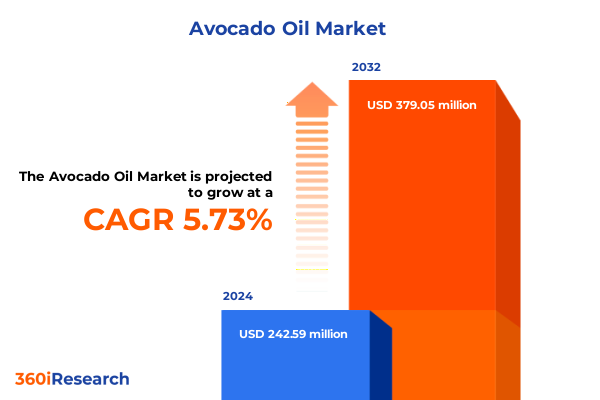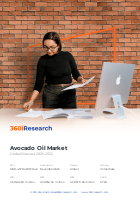The Avocado Oil Market size was estimated at USD 242.59 million in 2024 and expected to reach USD 254.55 million in 2025, at a CAGR of 5.73% to reach USD 379.05 million by 2032.

Exploring the Rise of Avocado Oil as a Premium Health-Forward Culinary Ingredient and Multifaceted Wellness Asset Driving Market Evolution
Avocado oil has emerged as a versatile, health-focused ingredient that resonates with today’s wellness-driven consumers. Celebrated for its high smoke point and neutral flavor, avocado oil offers a premium alternative to traditional cooking oils, catering to both professional chefs and home cooks seeking nutritional benefits without compromising taste. Its composition of monounsaturated fatty acids and vitamin E positions it as a functional food ingredient that aligns with modern dietary preferences, reinforcing its appeal across multiple culinary applications
Beyond the kitchen, avocado oil’s natural emollient properties have fueled its adoption in personal care formulations. Brands capitalizing on the clean-label movement leverage avocado oil to deliver moisturizing and antioxidant benefits in skincare and haircare products. This dual role underscores avocado oil’s potential as a cross-sector ingredient, bridging the gap between food and wellness markets while meeting consumers’ demands for transparency and minimal processing
Uncovering the Key Transformations Propelling Avocado Oil from Niche Specialty Product to Mainstream Culinary Staple and Beauty Essential
The clean-label revolution has propelled avocado oil into the spotlight as an antidote to highly processed seed oils. As scrutiny intensifies around omega-6–rich canola and soybean oils, avocado oil’s perception as a minimally refined, nutrient-dense option has galvanized consumer trust. Industry leaders emphasize cold-pressed extraction methods to preserve bioactive compounds, positioning avocado oil as a flagship item in clean-label portfolios and forging a distinct competitive advantage for forward-thinking manufacturers
Simultaneously, the culinary landscape has embraced avocado oil’s high-heat resilience and subtle flavor profile. Foodservice operators and artisanal food producers integrate avocado oil into premium product lines-ranging from air-fired potato chips to gourmet dressings-to cater to discerning diners. This shift is underpinned by data indicating a surge in refined, cold-pressed variants in retail channels, reflecting growing demand for versatile oils that accommodate both everyday cooking and specialty applications
Moreover, the beauty and personal care sectors are driving avocado oil into new arenas of product innovation. Topical formulations benefit from avocado oil’s emollient and anti-inflammatory characteristics, creating opportunities for multifunctional skincare and haircare treatments. Partnerships between food-grade processors and cosmetic manufacturers underscore a transformative trend: avocado oil is no longer confined to culinary uses but has become a cornerstone of natural beauty regimens, fostering cross-industry collaborations that elevate its market trajectory
Assessing the Aggregate Effects of 2025 United States Trade Tariffs on Avocado Oil Supply Chains, Pricing Volatility, and Market Accessibility
The United States’ 2025 trade policies introduced a 25% tariff on Mexican agricultural imports-including avocado oil-effective April 2, creating immediate uncertainty across supply chains. Although the measure was momentarily suspended on March 6, producers and exporters faced shipment halts as they awaited clarity on cost structures. This volatility has compelled key stakeholders to renegotiate contracts and explore alternative sourcing strategies, impacting both import volumes and contract pricing negotiations
Concurrently, the administration imposed a parallel 25% duty on goods from any country importing Venezuelan oil, aiming to weaken geopolitical adversaries. While this policy primarily targets energy flows, it resonates through interconnected vegetable-oil markets. Suppliers reliant on third-country processing, or those with transshipment arrangements, have faced additional compliance challenges and potential cost pass-throughs, further complicating the avocado oil supply matrix
In response to these dynamics, domestic processors and distributors are recalibrating their operations. With Mexican volumes constrained, U.S.-based refining facilities are exploring partnerships with Latin American and European producers to diversify raw material inflows. Meanwhile, consumer price sensitivity signals that cost escalation may not be fully absorbed upstream, indicating potential retail price adjustments. Companies that proactively adapt logistics networks and secure flexible sourcing agreements are positioned to mitigate tariff-induced disruptions and maintain market share
Illuminating Critical Segmentation Dimensions that Define Application, Grade, End-User, Distribution, and Packaging in the Avocado Oil Market Landscape
An in-depth view of market segmentation reveals that application categories steer product development and marketing strategies across the avocado oil value chain. In cosmetics and personal care, formulations are refined for hair care, lip care, and skin care uses, while dietary supplement players focus on liquid extracts and encapsulated forms. Within food and beverages, culinary options such as cooking oil, salad dressings, and spreads emerge alongside nutraceutical topical applications and capsules, underscoring the ingredient’s versatility across consumer needs. Grade distinctions-extra virgin, refined, and virgin-further delineate quality tiers, influencing both price positioning and technical specifications for specialized end uses. End-user segmentation covers foodservice & hospitality, households, and industrial & commercial channels, each with unique volume requirements and performance benchmarks. Distribution networks span online retail, pharmacies & drugstores, specialty stores, and supermarkets & hypermarkets, while packaging types-bottles, bulk containers, pouches & spouts, and sachets & packets-address logistical and convenience considerations, crafting tailored offerings for divergent customer segments.
This comprehensive research report categorizes the Avocado Oil market into clearly defined segments, providing a detailed analysis of emerging trends and precise revenue forecasts to support strategic decision-making.
- Grade
- Packaging Type
- Application
- End-User
- Distribution Channel
Highlighting Strategic Regional Dynamics Shaping Avocado Oil Demand Across the Americas, Europe Middle East Africa, and Asia Pacific Regions
In the Americas region, robust consumer affinity for avocado and avocado derivatives drives significant market activity. The United States, as the world’s largest per-capita consumer-surpassing nine pounds of whole avocados per individual in 2023-also anchors avocado oil demand in both retail and foodservice channels. Domestic initiatives to expand cultivation and processing, coupled with evolving tariff landscapes, emphasize the region’s strategic importance for supply stability and innovation
Within Europe, Middle East & Africa, avocado oil’s growth is fueled by Mediterranean diet adherence and clean-label regulations that favor minimally processed ingredients. European skincare brands leverage avocado oil in premium personal care lines, while North African and Middle Eastern markets exhibit rising interest in functional edible oils. Local producers are exploring sustainable farming and traceability certifications to meet evolving regulatory standards and consumer expectations, reinforcing the region’s role as both a production hub and growth frontier
Across Asia-Pacific, rapid urbanization and a burgeoning middle class have catalyzed demand for health-promoting oils. Urban China reported a double-digit increase in avocado oil consumption in 2023, while Australia and New Zealand embrace flavored and cold-pressed variants. E-commerce platforms and specialty retailers are instrumental in broadening market reach, enabling innovative product launches and premium positioning that resonate with tech-savvy, wellness-oriented consumers across the region
This comprehensive research report examines key regions that drive the evolution of the Avocado Oil market, offering deep insights into regional trends, growth factors, and industry developments that are influencing market performance.
- Americas
- Europe, Middle East & Africa
- Asia-Pacific
Profiling Leading Industry Players and Strategic Moves Driving Innovation, Sustainability, and Competitive Advantage in the Avocado Oil Sector
A review of leading industry participants underscores an era of strategic alliances and technology-driven expansion. Fresh Del Monte’s acquisition of a majority stake in Avolio exemplifies agricultural integration and capacity scaling, reinforcing its foothold in specialty oils. Concurrently, key players such as Chosen Foods, Mission Produce, Calavo Growers, and The Body Shop are diversifying portfolios through sustainable farming collaborations, product line extensions, and blockchain-based traceability initiatives, collectively advancing innovation and reinforcing supply chain resilience in the avocado oil sector
This comprehensive research report delivers an in-depth overview of the principal market players in the Avocado Oil market, evaluating their market share, strategic initiatives, and competitive positioning to illuminate the factors shaping the competitive landscape.
- AAK AB
- BetterBody Foods & Nutrition LLC.
- Bunge Limited
- CalPure Foods Inc.
- Chosen Foods LLC
- Olam International Limited
- Olivado Limited
- Olivado Limited,
- Ruchi Soya Industries Limited
- The Andersons, Inc.
Strategic Imperatives and Actionable Guidance for Industry Leaders to Capitalize on Avocado Oil Market Opportunities and Mitigate Emerging Risks
To capitalize on emerging opportunities and preempt market challenges, industry leaders should prioritize sustainable sourcing initiatives, including regenerative agriculture partnerships and fair-trade certifications, which reinforce brand trust and ensure long-term raw material availability. Expanding cold-pressed and organic product lines will address clean-label demands, while investments in advanced extraction and refining technologies can optimize yields and cost efficiencies. Geographic diversification-particularly in Asia-Pacific and EMEA markets-supported by robust e-commerce channels will broaden consumer access and mitigate regional supply disruptions. Finally, adopting digital traceability solutions such as blockchain enhances transparency, fortifies quality assurance, and meets growing regulatory and consumer scrutiny, positioning companies for continued growth and resilience.
Detailing the Rigorous Mixed-Method Research Framework Underpinning Comprehensive Analysis of the Global Avocado Oil Market Trends
This report employs a mixed-method research framework, commencing with secondary data collection from publicly available sources, trade compliance databases, and industry publications. Competitive intelligence is enriched through a thorough review of patent filings, company financials, and regulatory reports. Primary inputs are secured via structured interviews and surveys with stakeholders across the value chain, including growers, processors, distributors, and industry experts. Data triangulation and qualitative analysis ensure the integrity of insights, while scenario modeling evaluates the impact of trade policies and consumer trends. This systematic approach underlies the comprehensive assessment of the avocado oil market’s current state and future trajectories.
This section provides a structured overview of the report, outlining key chapters and topics covered for easy reference in our Avocado Oil market comprehensive research report.
- Preface
- Research Methodology
- Executive Summary
- Market Overview
- Market Insights
- Cumulative Impact of United States Tariffs 2025
- Cumulative Impact of Artificial Intelligence 2025
- Avocado Oil Market, by Grade
- Avocado Oil Market, by Packaging Type
- Avocado Oil Market, by Application
- Avocado Oil Market, by End-User
- Avocado Oil Market, by Distribution Channel
- Avocado Oil Market, by Region
- Avocado Oil Market, by Group
- Avocado Oil Market, by Country
- Competitive Landscape
- List of Figures [Total: 30]
- List of Tables [Total: 747 ]
Summarizing the Evolution, Opportunities, and Strategic Outlook of the Avocado Oil Market in a Rapidly Changing Global Food and Wellness Environment
As consumer preferences evolve toward health-forward, transparent, and sustainable products, avocado oil has transcended its niche origins to become a mainstream ingredient across food, wellness, and beauty sectors. Despite headwinds from trade policy fluctuations and supply chain constraints, the market’s resilience is evident in its diversified application landscape and ongoing investments by leading players. Companies that align with clean-label demands, pursue strategic regional expansion, and embed digital traceability will be best positioned to navigate volatility and harness growth. This dynamic environment underscores the importance of actionable insights and agile strategies to capitalize on the multifaceted opportunities that define the avocado oil market today.
Connect with Ketan Rohom to Secure In-Depth Avocado Oil Market Research Insights and Drive Strategic Decision Making with Our Comprehensive Report
To delve deeper into how these insights can inform your strategic initiatives and gain access to the full suite of market data and analysis, contact Ketan Rohom, Associate Director of Sales & Marketing. Engage directly to discuss customized report options and secure comprehensive research tailored to your business objectives, ensuring you stay ahead in the dynamic avocado oil landscape.

- How big is the Avocado Oil Market?
- What is the Avocado Oil Market growth?
- When do I get the report?
- In what format does this report get delivered to me?
- How long has 360iResearch been around?
- What if I have a question about your reports?
- Can I share this report with my team?
- Can I use your research in my presentation?




